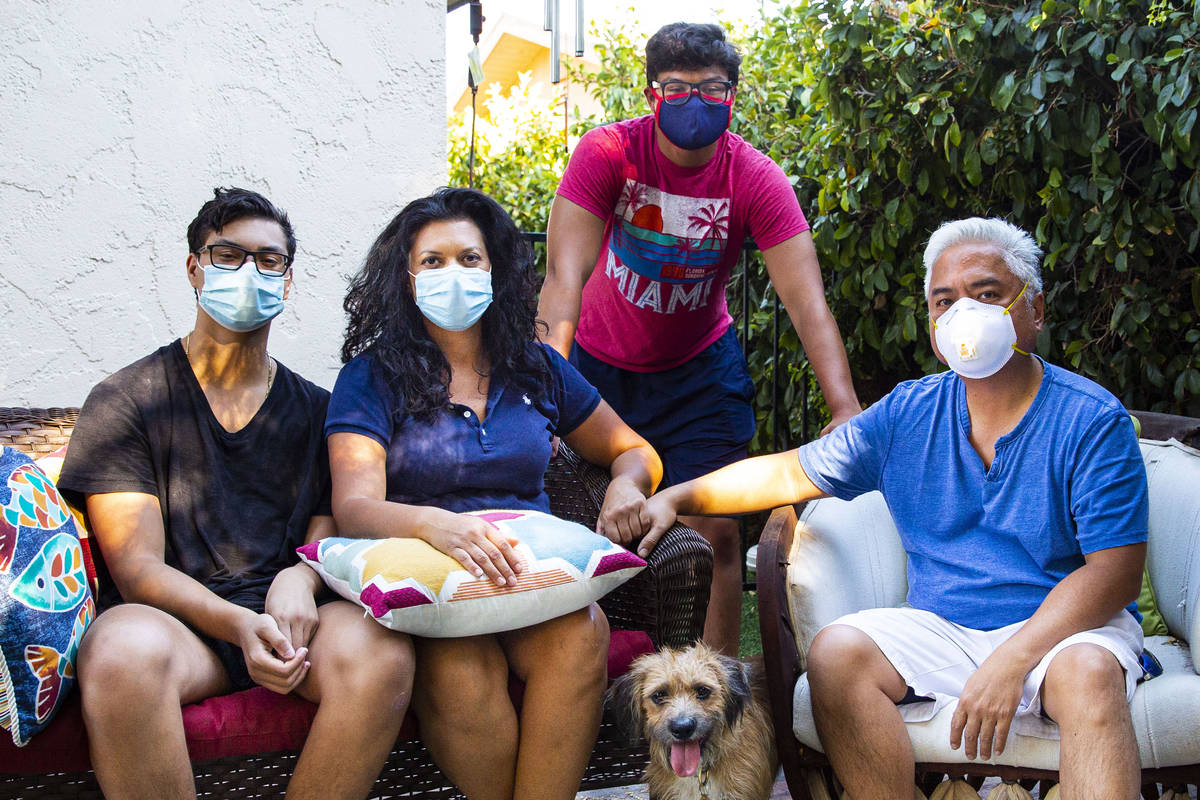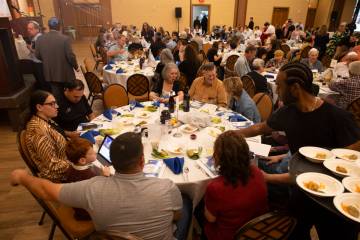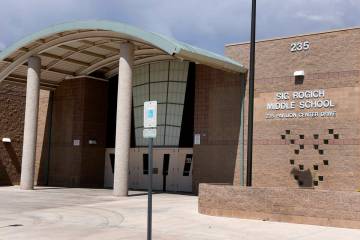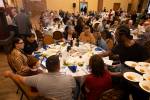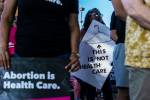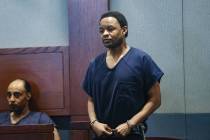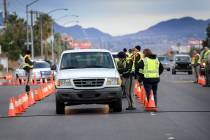Las Vegas ICU nurse shares personal war stories from the pandemic
A 92 percent occupancy rate might suggest that a hospital still has room for more patients. But the number, according to Las Vegas Valley ICU nurse Geoconda Hughes, does not tell the whole story.
It fails to convey the shortage of staff needed to treat growing numbers of patients hospitalized with COVID-19, she said.
The number that Hughes focuses on instead is a ratio: how many patients there are for each intensive care unit nurse. The typical ratio is one or two patients for each. Now there are three.
“We’re used to being precise and accurate and totally on top of everything,” Hughes, 47, said of the team of ICU nurses at St. Rose Dominican Hospital, Siena campus, in Henderson. “And we’re not able to do that with three patients. We don’t have eyes on our patients, and it’s very unsafe.”
These days, safety from COVID-19 is foremost on Hughes’ mind. Not just the safety of her patients, but her own and that of her family, including her two teenage sons. Already she had sent them away once to live with family members for a time as a precaution against the virus.
‘Forgive yourself’
It is not unheard-of for an ICU nurse to be assigned three patients, Hughes acknowledged. It happens during flu season, for example. And when it does, other nurses will rally around the busy nurse.
What’s unusual now is that so many of the ICU nurses are treating three patients.
“When the entire floor is on three-patient assignments, nobody can rally around anybody,” she said.
The requirements for COVID-19 patients can be especially demanding. It takes four nurses and a respiratory therapist to turn an ICU patient on a ventilator onto the stomach, a technique called proning, which improves lung capacity. But it means that three nurses are “not watching their full load (of patients),” Hughes said.
In response to Hughes’ concern, a spokesman for the hospital said officials are confident they have the people, equipment and resources to care for their patients.
“We are doing everything possible to ensure we are able to provide care for patients in our community,” spokesman Gordon Absher said. “This is a challenge facing hospitals around the state and the country. We are working across our organization, with community partners, and with local and state health officials to identify additional staffing resources.”
The Nevada Hospital Association said last week that regionally, hospitals have adequate capacity, including in ICUs, but that some individual facilities “are being stressed with high all-cause occupancy rates.”
The stress isn’t limited to the buildings.
Hughes took herself to task recently when because of patient volumes, she was unable to quickly attend to a patient who was thirsty. But now she gives herself the same counsel she gave colleagues who worked at hospitals in New York when they were overrun with COVID-19 patients: Forgive yourself.
‘That’s what makes me nervous’
“I’m going to have to forgive myself for letting that patient go thirsty,” she said. It doesn’t come easily. “I think of my grandmother or grandfather … and I wouldn’t want them to be thirsty.”
She worries about monitoring the vital signs of higher numbers of patients and what could happen when she calls for backup from a team stretched thin.
“I know somebody’s coming. I don’t know if somebody’s coming right now,” she said. “That’s what makes me nervous.”
She expressed concern that with the ICU at or near capacity, some patients can’t receive a higher level of care as soon as it’s needed. Other areas of the hospital are full as well, requiring some patients to sometimes stay for days in the emergency department.
The simple answer would be to hire more staff, though Hughes acknowledged that this is easier said than done. Recently, the contracts of three “travelers,” nurses who move from hospital to hospital, were due to be extended, but the nurses left for better-paying positions.
Absher said the hospital has been adapting its operations, sometimes on a daily basis.
“Nurses working additional shifts and in critical care areas are being compensated with incentive pay,” he said. “We also continue to work with traveling nurse agencies to secure available staffing resources to cover shifts as needed,”
But Hughes said more front-line troops are needed.
“They need to bring people in. If it means at a loss for the year, they just need to do it,” said Hughes, a union representative for National Nurses United, which has scheduled an informational picket at the hospital from 7:30 to 9 a.m. Wednesday to call for better staffing.
Union activism runs in the family. Hughes is the daughter of Geoconda Argüello-Kline, secretary-treasurer of Culinary Local 226 in Las Vegas.
To bolster staffing, nurses are working overtime. Hughes said that her 12-hour shifts have grown to 13. On her final shift of the week, she works 17 hours before taking the next three days off to rest up.
No shortcuts
Like her work life, Hughes’ home life has been transformed by the pandemic.
During the first coronavirus spike in the spring, she spent nearly seven weeks living apart from her sons to avoid the possibility that she might infect them. At the time, there were acute shortages of personal protective gear in hospital settings, especially the N95 medical-grade masks, considered to be the best protection against the virus.
Hughes now wears an N95 mask during her entire shift with the exception of the 27 minutes she takes for lunch. She won’t even remove it to take a sip of water except during her break.
“Every time you pull it off, you’re messing with the elastic; you’re messing with the seal,” she said. “I do not ever take a shortcut with COVID.”
Despite the precautions, Hughes fears becoming ill and bringing the virus home to her family. A dozen colleagues whom she sees on a regular basis have contracted COVID-19. One nurse tested positive this week for the virus along with most of her immediate family.
With the current surge in COVID-19 cases and hospitalizations, Hughes considered sending her sons to live with her parents for a second time.
But she’s reluctant to do so because her older son, Christopher, 18, is working as a lifeguard, a job that requires interaction with the public. She fears that he could become infected with the virus and unknowingly pass it on to her parents, who, because they are in their 60s, may be more vulnerable to its harmful effects.
So for now, she requires Christopher and Declin, 15, to practice strict social distancing and mask-wearing. After Christopher spent time with and hugged friends leaving home for the military, she required him afterward to self-quarantine at home for 12 days.
The two teens seem to take in stride the effect the pandemic has had on their social lives but not its toll on their mother.
Christopher worries that at some point she won’t “bounce back” from witnessing patients dying from COVID-19. Yet the pandemic has increased his resolve to become an EMT and join his mother in a medical field.
“I wanted mom to know she’s not alone, that someone else would understand,” he said.
A personal toll
ICU nurses are not as a rule “nervous Nellies,” Hughes said, but she acknowledged the toll the pandemic has taken on her.
She had the first panic attack of her life during a recent trip to Costco. She observed crowds of people, some with face masks dipping below their noses or removed during cell phone conversations. When an elderly woman entered her personal space to ask for help getting something off a shelf, Hughes thought, “This is more dangerous than work,” where at least she’s protected with an N95 mask.
Hughes is considering finding work that poses fewer hazards, though the timing is ironic. She completed her master’s degree in February and a few weeks ago passed her board exams to become a nurse practitioner. Her goal had been to become part of the intensivist group that oversees the ICU.
“But that means having to intubate patients. I don’t know that I’m up for that for the long haul,” she said.
Intubating involves inserting a breathing tube into a patient that connects to a mechanical ventilator. This process may expose a health care worker to aerosols and droplets from the patient’s airway, posing the threat of COVID-19 infection.
“It’s bittersweet because that’s what I was working toward for the last three years,” a goal that no longer seems so desirable, she said.
She is even considering working out of a hospital setting, perhaps in a clinic, putting greater distance between herself and the virus.
Meanwhile, she and her family adapt to life’s news stresses by enjoying the outdoors.
Last week, Hughes rented a convertible and the family took a drive to Pahrump.
Such diversions help, but only temporarily. Recurring thoughts about his mom and her job are a “really big stressor,” Declin said.
He added: “Every time I think about it, I’m not religious at all, but I start praying.”
Contact Mary Hynes at mhynes@reviewjournal.com or 702-383-0336. Follow @MaryHynes1 on Twitter.



